![]()
![]()
![]()
Use LEFT and RIGHT arrow keys to navigate between flashcards;
Use UP and DOWN arrow keys to flip the card;
H to show hint;
A reads text to speech;
73 Cards in this Set
- Front
- Back
|
A sound wave is a type of
|
longitudinal wave
|
|
|
A cork is floating on water in the middle of a tank. A pencil is dipped in the water on the left side of the dish to create a ripple
|
The cork moves up and down in the water as the wave passes.
|
|
|
In diffuse reflection, the light
|
reflects in many directions
|
|
|
The retinal cells responsible for color vision are
|
cones
|
|
|
What are the two kinds of reflection
|
specular and diffuse
|
|
|
A transverse pulse reflecting from a “free end” experiences a phase change of
|
The “free end” means there is no phase change, or 0 degrees phase change
|
|
|
A sound wave reflects from a wall. Upon reflection, the phase change is
|
Sound waves behave differently from transverse waves on ropes. Upon reflection from a hard surface, the sound wave has no phase change
|
|
|
A transverse pulse travels down a double rope, as shown. What happens when the pulse enounters the second, lightweight rope
|
The transmitted pulse will be upright. The reflected pulse will also be upright, since the boundary is a free end to the pulse on the first rope
|
|
|
What are mechanical waves and how do they work
|
disturbances or variations that travel through a medium from point to point, carrying energy.
As the waves travel through the medium, they locally displace some particles in the medium from their normal or “equilibrium” position. Those particles then oscillate about their equilibrium position. |
|
|
What are the two types of waves
|
Mechanical waves include water waves, sound waves, and waves on ropes or springs. Mechanical waves travel in a medium (such as air, water, glass, or rock).
Electromagnetic waves can travel in a medium or in a vacuum. |
|

The wavelength of the wave shown is
|
2 m.
The wavelength of the wave is the distance it takes for it to repeat. After 2 meters, the shape shown is the same as at 0. |
|
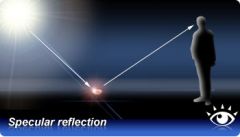
What is specular reflection
|
In specular reflection, light hitting the object from one direction is all reflected in another direction. A mirror reflects this way, as does any glossy surface. The still surface of a pond can give a specular reflection
|
|
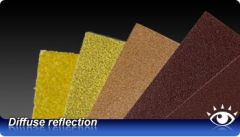
What is diffuse reflection
|
In diffuse reflection or scattering, light hitting the object from one direction is reflected in many directions. This gives the appearance of a matte surface. The rippled surface of wind-blown water will give a diffuse reflection. The Moon reflects light from the Sun in a diffuse way
|
|
|
How can waves carry energy without transporting matter. Name two examples
|
Notice that the wave carries energy without transporting matter.
The energy travels from one coil to the next in a slinky, but the coils themselves return to their original positions. A water wave can travel across a ripple tank, while a cork floating on the surface will bob up and down, but not travel across the tank with the wave. |
|
|
All progressive waves carry energy. Which direction does the energy travel
|
The same direction as the wave
|
|
|
What is the speed or velocity of a wave
|
how much time it takes for a pulse or wave to travel a given distance.
|
|
|
What is an example of a longitudanal wave
|
sound waves
|
|

In a longitudinal wave such as this one in a Slinky, the displacement of the medium is ______ to the direction of propagation of the wave.
|
parallel
|
|
|
Although a sound wave is a longitudinal wave, how does it differ
|

Air particles move back and forth instead of parts of the Slinky. Where the particles are more compressed the pressure is higher, and where the particles are more rarefied the pressure is lower.
|
|
|
What can sound waves travel through
|
solids and fluids, such as air and water
|
|
|
How are water waves special
|
Water waves combine longitudinal and transverse motions in the medium
|
|
|
Are electromagnetic waves transverse or longitudinal
|
transverse, but not mechanical. They do NOT require a medium
|
|
|
What media can electromagnetic or light waves travel in
|
air, water, and glass
|
|
|
Electromagnetic waves can transport energy in a
|
vaccuum
|
|
|
Electromagnetic waves consist of what fields
|
oscillating electric and magnetic fields
|
|
|
What is the speed of electromagnetic waves
|
in vacuum is always c, the speed of light ( `3 x 10^8` meters per second). In other media, the speed is less than c
|
|
|
Seismic waves travel through
|
Earth
|
|
|
Are seismic waves transverse or longitudinal
|
Can be either transverse or longitudinal
|
|
|
What are seismic waves cause by
|
earthquakes, explosions, meteor impacts
|
|
|
What is the name for longitudinal seismic waves
|
Compression or P (p for pressure) waves
|
|
|
What is the name for transverse seismic waves
|
Shear waves or S (shape of letter S represents the transverse oscillation) waves
Travel more slowly than P waves |
|
|
Can fluids transmit transverse waves
|
No
|
|
|
A seismic wave that caused the ground to move up and down would likely be
|
S waves, transverse waves. They would feel a bit like water waves passing through underfoot
|
|
|
Sound is a longitudinal wave, but can also be represented as a ______ wave
|
sine
|
|
|
What medium can sound travel through
|
Any kind of medium — gas, liquid, or solid
|
|
|
What is the speed of sound through air
|
Sound travels through air at about 340 meters per second
The thunder sound from the same lightning strike 8 km away takes 24 seconds to reach your ears. |
|
|
What is the speed of light
|
Light travels at `3 x 10^8` meters per second. If lightning strikes 5 miles (8 km or `8 x 10^3 m`) away, the time it takes to reach your eyes is `2.7 x 10^(-5)` seconds, or 27 milliseconds.
|
|
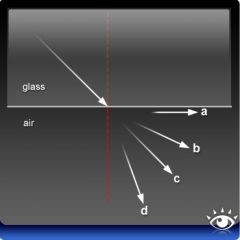
Light shining through glass emerges into air. The speed of light in glass is slower than in air. What is the likely path of the light in the air: a, b, c, or d?
|
The wave or ray of light coming into the medium where the speed is faster bends away from the normal (shown here by a dashed red line). If there were no change in speed in the new medium, the path would have been ray C. If the speed had slowed in the new medium, the path would be ray D. But the speed is faster in air than in glass so the path is ray B.
|
|
|
Consider a rope that is fixed to a wall. A transverse pulse sent down the rope reaches the wall and reflects, traveling back to its point of origin. The reflected pulse is ________
|
upside down
|
|

Consider a rope that is fixed to a wall. A transverse pulse sent down the rope reaches the wall and reflects, traveling back to its point of origin.
The reflected pulse is _______ |
upside down
|
|
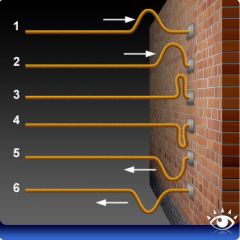
Reflection of a pulse from a fixed point. The reflected pulse is upside down, or 180 degrees out of phase with the initial pulse.
What is the displacement |
0
|
|

The two points where the wave has zero displacement from the mean would be at 90 degrees and 270 degrees. The two points where the wave has zero displacement from the mean would be at
|
90 degress and 270 degrees
|
|
|
the fixed point is where the incoming and reflected waves
|
interfere destructively or cancel out
|
|
|
What phase change does the reflected pulse undergo at the reflection point
|
180 degrees
|
|
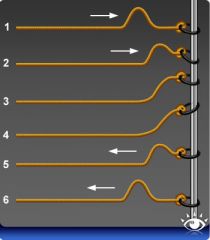
This is the reflection of a pulse from a point that is free to move in the transverse direction
Has the reflected pulse undergone a phase change |
No, the reflected pulse is the same way up as the incident pulse, and has not undergone any phase change
|
|
|
Can light reflect with 0 phase change, like the pulse reflecting off a free-end boundary?
|
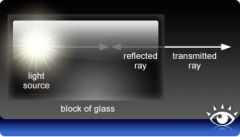
Yes. Light traveling in glass meets the glass/air boundary. The reflected ray has no phase change, since the air is less dense than the glass.
|
|
|
Light and waves on a rope are examples of
|
transverse waves
|
|
|
How do sound waves differ from light or waves on a rope
|
There is no phase change for reflection of sound from air to a rigid surface
|
|
|
What is the phase change if a sound traveling in a solid encounters a boundary with air
|
the sound is reflected with 180 degrees phase change
|
|
|
What is the law of reflection
|

The way light rays reflect off plane (flat) mirrors or surfaces is very simple: the angle of incidence is equal to the angle of reflection.
|
|
|
The index of refraction in a medium is 1.8. What is the speed of light in the medium?
|
`n = c/v` therefore `v = c/n = (3.0 x 10^8 "m/s")/1.8 = 1.7 x 10^8 "m/s"`
|
|
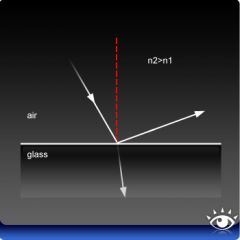
A ray of light in air shines on a piece of glass. The index of refraction in glass is greater than the index of refraction in air. What is wrong with the picture?
|
The angle of reflection should equal the angle of incidence. In this diagram, the reflected ray emerges at too great an angle.
|
|
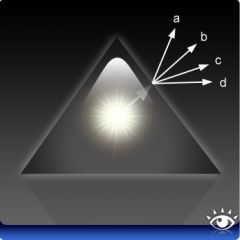
A ray of light inside a triangular glass prism emerges into air. (The index of refraction of glass is greater than that of air.) Which way does the ray emerge?
|
B. The incident ray approaches the boundary at the normal to the glass-air boundary, so it is not refracted
|
|
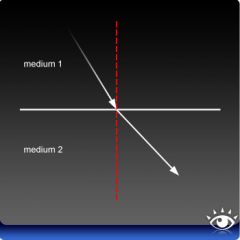
A ray of light travels from medium 1 to medium 2, as shown in the diagram. Which medium has the higher index of refraction, and why?
|
Medium 1, because the ray makes a smaller angle to the normal there.
The ray of light moves away from the normal in medium 2. Therefore medium 2 has the lower index of refraction, and medium 1 the higher |
|
|
What is refraction
|
the changing of direction and speed of light when it goes from one medium to another.
|
|
|
A light wave changes when it enters a different
|
medium
|
|

This is an example of
|
Refraction. Light in a vacuum slows down when it enters a block of glass. When it emerges from the block of glass, it resumes a speed of `c = 3 x 10^8 "m/s"`
|
|
|
What is the refractive index
|
The refractive index (n) is just c divided by the speed of light in the medium:
`n_(medium)" = c/(v_(medium)` |
|

When light enters a new medium, it not only changes speed, it changes direction.
What is the only exception |
The only exception is if light enters the medium along the normal — that is, perpendicular to the surface
Light entering a new medium along the normal does not change direction. Light entering a new medium at an angle is deviated toward the normal if the new medium has a higher index of refraction. |
|
|
Why does the light coming in at an angle change direction
(Hint:grassy area/shopping car analogy) |
when a beam of light enters a medium of higher index of refraction, the edge of the beam that first enters the medium will slow down while the other edge is still traveling fast
|
|

A ray of light in glass is incident on the glass-air boundary as shown, and the refracted ray emerges exactly along the boundary. What angle does the refracted ray make with the normal to the glass surface?
|
The refracted ray emerges at 90 degrees to the normal. This does happen! If you are curious, you can look up “total internal reflection
|
|
|
Sketch the incident, reflected, and refracted rays for light going from glass to a vacuum. The incident ray makes an angle about 30 degrees to the normal.
What are the first two steps |
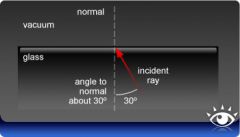
To solve this problem, first draw the two media and the normal to the surface.
Second, draw the incident ray of light. |
|
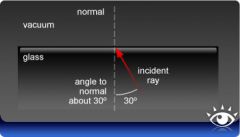
Draw the reflected ray of light
|

Remember that the angle of incidence is equal to the angle of reflection.
|
|
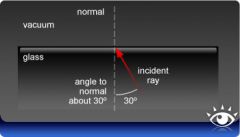
Draw the refracted ray.
|

The light is going into a medium of LOWER index of refraction than the one it is in, so it will bend AWAY from the normal.
|
|
|
What type of lens is in a camera
|
A camera contains a converging lens, which creates a real image in the plane of the CCD sensor or on film.
|
|
|
does the size of the lens of a camera change the size of the image
|
No
|
|
|
changing the _____ ______ of a lens of a camera changes the size of the image
|
focal length
|
|
|
How many converging lenses does a refracting telescope use and what are their purposes
|
Two:a large one at the opening of the telescope to collect light, and a small one in the eyepiece to bring the image to the eye or sensor
|
|
|
Which lens on the telescope is longer, the objective or the eyepiece
|

The focal length of the objective lens is longer than the focal length of the eyepiece lens.
|
|

Explain how the lenses of the telescope work
|
The objective lens collects parallel rays of light from a distant object, such as a star or galaxy. The objective lens brings these rays to a focus at its focal point. The rays form a real image of the celestial object.
The eyepiece lens has its focal point at the same place as the objective lens, so the image of the objective lens serves as the object for the eyepiece lens. The eyepiece lens generates parallel rays in a small bundle that can enter the eye or camera |
|
|
Which is longer in a microscope, the focal length of the objectice lens or eyepiece lens
|

The focal length of the objective lens in a microscope is small, and the eyepiece focal length long; this is the reverse of the case for a telescope.
|
|
|
How does the microscope work
|

The object is just outside the focal point of the objective lens. The image formed by the objective is at the focal point of the eyepiece. The eyepiece acts as a simple magnifying glass for viewing the image.
|
|

What is the device shown in this diagram? Hint: It is drawn a little differently from the way we have drawn devices here. The important features are the focal length of the objective compared to the eyepiece, the location of the object, and the locations of the objective and eyepiece focal points. Fo identifies the focal points of the objective lens, and Fe the focal points of the eyepiece lens
|
Microscope. The focal length of the objective is short compared to the focal length of the eyepiece. Also, there is some distance separating the focal points of the objective and eyepiece, between the lenses
|

